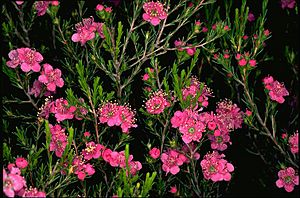Mount Melville kunzea facts for kids
Quick facts for kids Mount Melville kunzea |
|
|---|---|
 |
|
| Kunzea pauciflora in the ANBG | |
| Conservation status | |
| Scientific classification | |
| Genus: |
Kunzea
|
| Species: |
pauciflora
|
Kunzea pauciflora, also known as the Mount Melville kunzea, is a special type of flowering plant. It belongs to the family called Myrtaceae, which includes plants like eucalyptus. This plant is only found in a small area on the south coast of Western Australia. It is a shrub with many branches and pretty pink flowers that usually grow near the top of the plant.
Contents
What the Mount Melville Kunzea Looks Like
The Mount Melville kunzea is a shrub that typically grows to a height of about 0.35 to 1.5 meters. That's roughly from your knee to taller than you! Its stems have many branches, especially near their ends.
The leaves are long and thin, like tiny lines. They are about 3.5 to 6.5 millimeters (mm) long and 0.4 to 1.0 mm wide. They sit on a small stalk called a petiole, which is about 0.4 to 1.0 mm long.
The flowers are usually pink. They appear one by one, in pairs, or in small groups of three to five. You'll find them near the ends of the branches, often at the very top of the shrub.
At the base of the flowers, there are small, egg-shaped leaves called bracts. They are about 2.5 to 3.5 mm long. There are also tiny, lance-shaped leaves called bracteoles right at the flower's base.
The sepals are like small, green triangles that protect the flower bud. They are about 2 to 2.6 mm long. The petals are pink and look like egg shapes or are almost round. They are about 3.5 to 4 mm long.
Inside the flower, there are between 39 and 46 stamens. These are the parts that produce pollen. They are about 3.3 to 4.1 mm long and are arranged in several circles, called whorls.
This plant flowers between August and November. After flowering, it produces a fruit that is an urn-shaped capsule. The sepals stay attached to the fruit.
How the Mount Melville Kunzea Got Its Name
The scientific name of a plant helps scientists around the world know exactly which plant they are talking about. The Mount Melville kunzea was first officially described in 1844 by a scientist named Johannes Conrad Schauer. He published his description in a book called Plantae Preissianae. The plant he studied was collected near Cape Riche.
The second part of its scientific name, pauciflora, comes from two Latin words. Paucus means "few" or "little," and flos means "flower" or "blossom." So, pauciflora means "few flowers," which describes how the flowers usually appear in small groups.
Where the Mount Melville Kunzea Lives
The Mount Melville kunzea is found in a specific area near the coast of Western Australia. It grows on hillsides and slopes around Cape Riche. This area is part of the Fitzgerald River National Park.
This plant prefers to grow in gravelly, sandy, or loamy soils. These soils are usually found over limestone or sandstone rocks.
Protecting the Mount Melville Kunzea
The Government of Western Australia's Department of Parks and Wildlife has a special list for plants that need protection. The Mount Melville kunzea is classified as "Priority Four" on this list.
Being "Priority Four" means that the plant is rare or nearly threatened. This classification helps make sure that efforts are made to protect this unique plant and its habitat, so it can continue to grow in the wild for many years to come.


